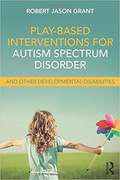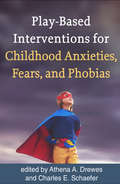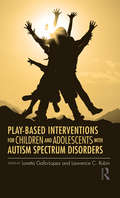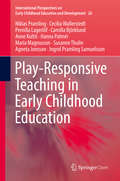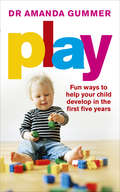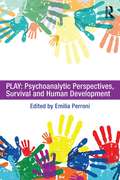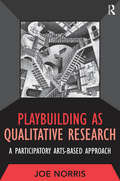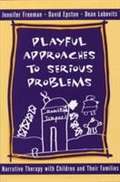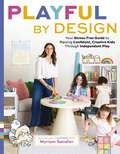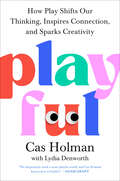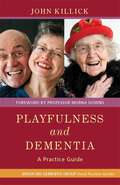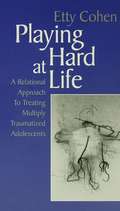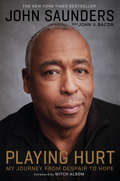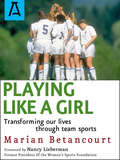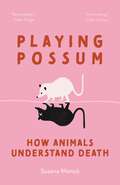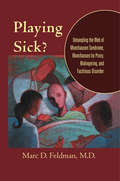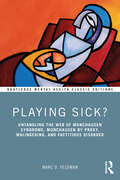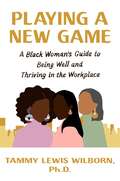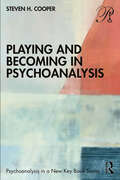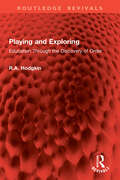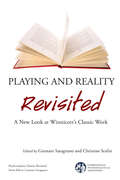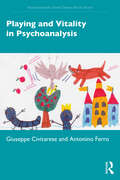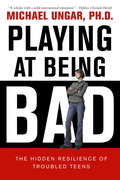- Table View
- List View
Play, Learning, and Children's Development
by Marilyn Fleer Mariane HedegaardThis book explores the dynamics in children's everyday lives as they move between school and the family, with particular consideration of how children's motives change in response new challenges. Professors Mariane Hedegaard and Marilyn Fleer follow four children, two from Australia and two from Denmark, over a twelve-month period. Using these case studies, they show how children's everyday activities, play, and the demands of both family and educational contexts influence their learning and development. The authors contribute to a sociocultural theory formulation that includes the child's perspective in cultural historical contexts. Their approach yields insights that transcend specific nationalities, cultures, and socioeconomic situations. The analysis shows not just how children's family life shapes their experiences in school, but how schools influence and shape their lives at home.
Play, Playfulness, Creativity and Innovation
by Paul Martin Patrick BatesonWhat role does playful behaviour and playful thought take in animal and human development? How does play relate to creativity and, in turn, to innovation? Unravelling the different meanings of 'play', this book focuses on non-aggressive playful play. The authors emphasise its significance for development and evolution, before examining the importance of playfulness in creativity. This discussion sheds new light on the links between creativity and innovation, distinguishing between the generation of novel behaviour and ideas on the one hand, and the implementation of these novelties on the other. The authors then turn to the role of play in the development of the child and to parallels between play, humour and dreaming, along with the altered states of consciousness generated by some psychoactive drugs. A final chapter looks forward to future research and to what remains to be discovered in this fascinating and important field.
Play-Based Interventions for Autism Spectrum Disorder and Other Developmental Disabilities
by Robert Jason GrantPlay-Based Interventions for Autism Spectrum Disorder and Other Developmental Disabilities contains a wide selection of play therapy interventions for use with children and adolescents with autism spectrum disorders, dysregulation issues, or other neurodevelopmental disorders. <P><P>The structured interventions focus on improvement in social skills, emotional regulation, connection and relationship development, and anxiety reduction. Special considerations for implementing structured interventions and an intervention tracking sheet are also presented. <P><P>This valuable tool is a must have for both professionals and parents working on skill development with these populations.
Play-Based Interventions for Childhood Anxieties, Fears, and Phobias
by Charles E. Schaefer Athena A. DrewesIllustrating the power of play for helping children overcome a wide variety of worries, fears, and phobias, this book provides a toolkit of play therapy approaches and techniques. Coverage encompasses everyday fears and worries in 3- to 12-year-olds as well as anxiety disorders and posttraumatic problems. Leading practitioners describe their approaches step by step and share vivid illustrative case material. Each chapter also summarizes the research base for the interventions discussed. Key topics include adapting therapy to each child's developmental level, engaging reluctant or less communicative clients, and involving parents in treatment.
Play-Based Interventions for Children and Adolescents with Autism Spectrum Disorders
by Lawrence C. Rubin Loretta Gallo-LopezPlay-Based Interventions for Children and Adolescents with Autism Spectrum Disorders explores the most recognized, researched, and practical methods for using play therapy with the increasing number of children diagnosed with Autism Spectrum Disorders (ASDs), and shows clincians how to integrate these methods into their practices. Using a diverse array of play-based approaches, the book brings together the voices of researchers and practicing clinicians who are successfully utilizing play and play-based interventions with children and adolescents on the autism spectrum. It also examines the neurobiological underpinnings of play in children on the autism spectrum and the overall effect of play on neuro-typical and neuro-atypical development. Finally, through careful integration of theory with real-world clinical case application, each chapter also shows clinicians how to incorporate a particular treatment approach and make it a viable and effective part of their work with this challenging clinical population.
Play-Responsive Teaching in Early Childhood Education (International Perspectives on Early Childhood Education and Development #26)
by Niklas Pramling Hanna Palmér Cecilia Wallerstedt Pernilla Lagerlöf Camilla Björklund Anne Kultti Maria Magnusson Susanne Thulin Agneta Jonsson Ingrid Pramling SamuelssonThis open access book develops a theoretical concept of teaching that is relevant to early childhood education, and based on children’s learning and development through play. It discusses theoretical premises and research on playing and learning, and proposes the development of play-responsive didaktik. It examines the processes and products of learning and development, teaching and its phylogenetic and ontogenetic development, as well as the ‘what’ of learning and didaktik. Next, it explores the actions, objects and meaning of play and provides insight into the diversity of beliefs about the practices of play. The book presents ideas on how combined research and development projects can be carried out, providing incentive and a model for practice development and research. The second part of the book consists of empirical studies on teacher’s playing skills and examples of play with very young as well as older children.
Play: Fun ways to help your child develop in the first five years
by Dr Amanda GummerPlay is a fantastic way to promote family cohesion, enhance child development, reduce stress and encourage parents and children to enjoy their family life. Play is a practical and inspiring book for all parents who want to support their child’s development in a fun and pressure free way. Written by a child development expert and play psychologist, it’s packed with activities and insights to help parents support their child through the critical first five years of life. Find out: · Why babies love peekaboo and how to promote attachment through laughter · What toys to buy and what games to play at each developmental stage and why · How to use musical play to lay the foundations for learning languages and maths · Ways to manage sibling rivalry, tantrums, ADHD and fussiness through games · Activities to increase mobility, creativity, confidence, cognitive and social skills Giving the confidence back to parents, and showing them that the tools they need are already at their fingertips, Play is for every parent who wants a playful and stress-free solution to helping their child to reach their full potential.
Play: Psychoanalytic Perspectives, Survival And Human Development
by Jeff Green Emilia Perroni Peter GandolfiIs play only a children’s activity? How is the spontaneous play of adults expressed? What is the difference between “play” and “game”? What function does play have during war? Play:Psychoanalytic Perspectives, Survival and Human Development explores the importance of play in the life of the individual and in society. Most people associate psychoanalysis with hidden and “negative” instincts, like sexuality and aggressiveness, very seldom with “positive urges” like the importance of love and empathy, and almost never with play. Play, which occupies a special place in our mental life, is not merely a children’s activity. Both in children and adults, the lack of play or the incapacity to play almost always has a traumatic cause – this book also shows the crucial importance of play in relation to the survival in warfare and during traumatic times. In this book Emilia Perroni argues that whether we regard play as a spontaneous creation or whether we see it as an enjoyable activity with defined rules (a game), that it is impossible to conceive human existence and civilization without it. The papers collected in this book are the results of the research offered on the subject of play by several Israeli therapists from different psychoanalytic schools Freudian, Jungian, Kleinian, Winnicottian and Self-Psychology. Other contributions are from Israeli researchers and academics from various fields such as literature, music, art, theatre and cinema, contemporary psychoanalysis and other disciplines. Play: Psychoanalytic Perspectives, Survival and Human Development offers new ways to think about, and understand, play as a search for meaning, and as a way of becoming oneself. This book will be of interest to psychoanalysts, researchers, therapists, parents, teachers and students who are interested in the application of psychoanalytic theory to their fields including students of cultural studies, art, music, philosophy. Emilia Perroni is a clinical psychologist, supervisor at the School of Psychoanalytic Psychotherapy at the University of Tel Aviv and the Bar Ilan University. She has a private practice in Jerusalem and in Tel Aviv. She is a member of the Israeli Association of Psychoanalytic Psychotherapy, the Israeli Association of Psychotherapy, she is an Associated-Member of the Israeli Institute of Jungian Psychology, and Research Fellow at the Van Leer Institute in Jerusalem.
Playbuilding as Qualitative Research: A Participatory Arts-Based Approach (Developing Qualitative Inquiry #5)
by Joe NorrisThis book is for both art-based researchers and research-informed artists, exploring the theatrical genre known as Collective Creation, or Playbuilding. Performers generate data around chosen topics— from addiction and sexuality to qualitative research—by compiling scenes from their disparate voices. Audience members become involved in the investigation, and the performed scenes do not end the conversation but challenge and extend it. Through discussion and audience participation, the process examines how knowledge is defined and how data is mediated.
Playful Approaches to Serious Problems: Narrative Therapy with Children and their Families
by David Epston Jennifer Freeman Dean LobovitsThe "grown-up talk" of therapy is likely to turn off children - especially if it focuses on their problematic behavior. The highly effective techniques of narrative therapy include children by respecting their unique language, stories, and views of the world. This book describes a basic theory of collaborative narrative play, as well as verbal and nonverbal techniques that clear the way for stories of hope, possibility, and change. Compelling case examples, drawn from the authors' work, will appeal to parents and educators as well as therapists.
Playful by Design: Your Stress-Free Guide to Raising Confident, Creative Kids through Independent Play
by Myriam SandlerHelp your kids grow into confident, creative, and independent little people by creating spaces in your home that foster independent play.Myriam Sandler, creator and founder of Mothercould, helps you give your kids the tools they need to unlock their imaginations and encourage kid-directed, kid-executed, and ultimately kid-enriching independent play using the materials and spaces you already have. Not only will this system help your children grow, it will also help foster a more connected, more productive, and happier home for your entire family.Through colorful photography and vibrant illustration Playful by Design is your blueprint for effortlessly designing, installing, and maintaining your own upgraded play spaces. Myriam Sandler has created a resource to help you—easily and affordably—create spaces for independent play, no matter how big or small your home is.Myriam shares activities that:Build problem-solving skillsEncourage social and academic developmentEngage children while building moments of play and connectionNurture independence and self-expressionHelp work through emotions, andOffer parents important parenting wins that benefit the entire family As your kids engage with self-directed, open-ended play, you'll realize what a game-changer this new dynamic is for the entire household. For the parents, there's no more feeling overwhelmed and stretched thin by unrealistic expectations about how to entertain your kids. And for your kids, you're giving them the most beautiful gift: the ability to be independent self-starters who are in touch with their own creativity. In short: everyone will feel happier, more energized, more fulfilled, and more connected.Myriam will help you:Plan the spaceDeclutterOrganize by type (and customize for various age groups!)Set up a toy rotation systemMaintain (easily and efficiently!) In addition to the how, Myriam explains the why. This beautifully designed book will equip you to understand the importance of independent play, as well as set it into motion. You'll discover that boredom can be a good thing, and you'll see how it can make their imaginations blossom. This type of play creates more time for your kids to grow as creative and independent little people; more time for you to do the things you need and want to do; more peace of mind that you are, in fact, giving your kids important tools they'll thank you for one day; and more opportunities to feel the joy of all of the above.
Playful: How Play Shifts Our Thinking, Inspires Connection, and Sparks Creativity
by Cas HolmanA designer, educator, and play expert calls for adults to add more fun, exploration, and imagination to their lives&“Radiant and essential … this book brings a sense of transcendence. Reading it was not only inspiring; it was joyful.&” —Elizabeth Gilbert, NYT bestselling author of Big MagicWe&’re all born playful. But when we grow up, we learn to suppress this critical, hardwired instinct and our lives become ruled by &“getting things done.&” As world-famous designer Cas Holman explains, this disconnection from our playful selves is hazardous to everything from our emotional wellbeing to our ability to problem solve and innovate. The emerging science of play shows that it sparks joy, wonder, creativity, and insight at any age. Here, Holman explains the power of &“free play&” through open-ended, unstructured activities that we become absorbed in with no obvious goal or purpose. The ways we can play are endless and what recharges us most is unique to each of us: whether it&’s a piece of art we create, an entertaining conversation with a stranger, or an experiment to shake up a routine task. Weaving in inspiring stories and eye-opening research, Holman shows us that adopting a playful mindset is crucial in helping us:Overcome fear of failure and embrace new ways of thinkingDestress, reset, and connect with each otherGrow our creativity at every stage of our livesFind joy in bleak timesPlayful draws on psychology, history, art, and design thinking to make a powerful case for the vital importance of play for grown-ups in a world obsessed with productivity. Provocative, wise, and full of spirit, it will inspire you to (re) learn how to play.
Playfulness and Dementia
by John KillickEstablishing playfulness as an essential component of dementia care, this positive and uplifting book will be key in changing attitudes and providing ideas for new and valuable ways of interacting and being with individuals with the condition. John Killick explores the nature of playfulness and the many ways in which it can enrich the lives of people with dementia, including as a means of maintaining relationships and communication, supporting communication and generally lifting the spirits. Specific approaches already in existence are described, including improvised drama, clowning and laughter yoga, and a chapter on the playful approach to art and craft activities is also included. Personal accounts of playfulness by individuals with dementia, relatives and an actor with a decade's experience of using playful approaches with people with dementia offer rich first-hand insights into its transformative potential. Throughout the book, the importance of spontaneity and of being with the person with dementia in the present moment is emphasised, and the reader is encouraged to develop a playful mindset. A selection of colour photographs amply demonstrate playful approaches in action. Offering a fresh and perhaps unexpected perspective, this book is essential reading for dementia care practitioners and managers, activity coordinators, therapists, people with dementia and their relatives, and anyone else concerned with the wellbeing of those with the condition.
Playing Hard at Life: A Relational Approach to Treating Multiply Traumatized Adolescents
by Etty CohenPlaying Hard at Life brings contemporary relational thinking to bear on the psychodynamic treatment of a notably difficult group of young patients. Working with New York City teenagers who have survived the wars of inner-city life and Israeli teenage soldiers who have survived the wars of the Middle East, author Etty Cohen documents the extraordinary challenges of forming a treatment alliance with these shattered youngsters, of engaging them psychodynamically, and of working toward a viable termination. The result is not only a poignant record of courage and committment (on the part of patient and therapist alike), but also a valuable extension of modern trauma theory to adolescence as a developmental stage with its own challenges and requirements.The heart and strength of Cohen's book is her vivid documentation of hands-on encounters with her adolescent patients, seen both individually and in group. Cohen makes plain that, with young people so horrendously traumatized, treatment assures a necessarily improvisational character. And yet, she argues, even in the type of pragmatic encounters dictated by massive and repeated trauma, contemporary relational theory provides a compass with which to navigate through the rocky shoals of the clinical work. Again and again, the reader is shocked by just how much happened to these adolescents, astonished at how resilient they proved to be, and, finally, moved by how much Cohen was able to accomplish with them. Her relational approaches to these treatments, teamed with her realization that work with multiply traumatized adolescents cannot be structured in the manner of conventioanl therapy, makes this book an invaluable, timely, and deeply sobering contribution to the literature.
Playing Hurt: My Journey from Despair to Hope
by Mitch Albom John U. Bacon John SaundersFor the first time ever, the popular late host of ESPN's The Sports Reporters and ABC's college football openly discusses a lifelong battle with depression.During his three decades on ESPN and ABC, John Saunders became one of the nation's most respected and beloved sportscasters. In this moving, jarring, and ultimately inspiring memoir, Saunders discusses his troubled childhood, the traumatic brain injury he suffered in 2011, and the severe depression that nearly cost him his life. As Saunders writes, Playing Hurt is not an autobiography of a sports celebrity but a memoir of a man facing his own mental illness, and emerging better off for the effort. I will take you into the heart of my struggle with depression, including insights into some of its causes, its consequences, and its treatments.I invite you behind the facade of my apparently "perfect" life as a sportscaster, with a wonderful wife and two healthy, happy adult daughters. I have a lot to be thankful for, and I am truly grateful. But none of these things can protect me or anyone else from the disease of depression and its potentially lethal effects.Mine is a rare story: that of a black man in the sports industry openly grappling with depression. I will share the good, the bad, and the ugly, including the lengths I've gone to to conceal my private life from the public.So why write a book? Because I want to end the pain and heartache that comes from leading a double life. I also want to reach out to the millions of people, especially men, who think they're alone and can't ask for help. John Saunders died suddenly on August 10 ,2016, from an enlarged heart, diabetes, and other complications. This book is his ultimate act of generosity to help those who suffer from mental illness, and those who love them.
Playing Like a Girl: Transforming Our Lives Through Team Sports
by Marian BetancourtMore and more women and girls are discovering the joy and relishing the fierce competition of team sports. Their increasing participation in sports is influencing all aspects of women's--and men's--lives. Playing Like a Girl explores the ramifications of this sports revolution, such as the change in male-female relationships, the impact on women in the workplace, the long-term effects of Title IX, and the phenomenon of men coaching women. These ideas are explored through stories of women from grandmothers playing basketball in the Senior Olympics, to working women who get up before dawn to row on the Potomac River. Robert Lipsyte, writing in The New York Times, said, "For a wider look at the obstacles and opportunities facing the emergent female athlete, read, Playing Like a Girl." Jo A. Hannafin, MD, PhD, founder of the Women's Sports Medicine Center Hospital for Special Surgery and team physician, U.S. Rowing Team, called the book, "A wonderful compilation of personal stories and hard facts, which provide compelling evidence for the power of team sports in the development of strong and successful women.
Playing Possum: How Animals Understand Death
by Susana MonsóHow animals conceive of death and dying—and what it can teach us about our own relationships with mortalityWhen the opossum feels threatened, she becomes paralyzed. Her body temperature plummets, her breathing and heart rates drop to a minimum, and her glands simulate the smell of a putrefying corpse. Playing Possum explores what the opossum and other creatures can teach us about how we and other species understand mortality, and demonstrates that the concept of death, far from being a uniquely human attribute, is widespread in the animal kingdom.With humor and empathy, Susana Monsó tells the stories of ants who attend their own funerals, chimpanzees who clean the teeth of their dead, dogs who snack on their caregivers, crows who avoid the places where they saw a carcass, elephants obsessed with collecting ivory, and whales who carry their dead for weeks. Monsó, one of today&’s leading experts on animal cognition and ethics, shows how there are more ways to conceive of mortality than the human way, and challenges the notion that the only emotional reactions to death worthy of our attention are ones that resemble our own.Blending philosophical insight with new evidence from behavioral science and comparative psychology, Playing Possum dispels the anthropocentric biases that cloud our understanding of the natural world, and reveals that, when it comes to death and dying, we are just another animal.
Playing Sick?: Untangling the Web of Munchausen Syndrome, Munchausen by Proxy, Malingering, and Factitious Disorder
by Marc D. FeldmanTaken from bizarre cases of real patients, Playing Sick? is the first book to chronicle the devastating impact of phony illnesses--factitious disorders and Munchausen syndrome--on patients and caregivers alike. Based on years of research and clinical practice, Playing Sick? provides the clues that can help practitioners and family members recognize these disorders, avoid invasive procedures, and sort out the motives that drive people to hurt themselves and deceive others. With insight and years of hands-on experience, Feldman shows how to get these emotionally ill patients the psychiatric help they need.
Playing Sick?: Untangling the Web of Munchausen Syndrome, Munchausen by Proxy, Malingering, and Factitious Disorder (Routledge Mental Health Classic Editions)
by Marc D. FeldmanIn the classic edition of this outstanding book, originally published in 2004, Dr. Marc Feldman explores the bizarre cases of real patients who feign or even self-induce illness. Playing Sick? chronicles the devastating impact of illness hoaxes, including factitious disorders, Munchausen syndrome, Munchausen by proxy, and malingering. Based on years of research and clinical practice, Playing Sick? provides the clues that can help professionals, family members, friends, and patients themselves to recognize these diagnoses, avoid invasive procedures, and understand elusive motives. Dr. Feldman offers practical advice to get emotionally ill patients the help they need. This classic edition is essential reading for physicians, social workers, and anyone interested in why and how individuals fabricate illness.
Playing a New Game: A Black Woman's Guide to Being Well and Thriving in the Workplace
by Tammy Lewis Wilborn, PhDDrawing on first-hand clinical insight and scientific research, Dr. Wilborn offers much-needed advice on how women of color can be high-performing and successful professionally, without sacrificing their physical, mental, and emotional wellness. Black and brown women have been making profound strides in leadership and professional achievement, despite facing the added hurdles of both sexism and racism in the workplace. But so often, excelling at work comes at the expense of their wellness: the chronic stressors and demands on Black women can result in negative physical health outcomes such as sleep disturbance, hypertension, and diabetes, and negative mental health outcomes including anxiety and depression. We cannot talk about career advancement for Black and brown women without talking about strategies that promote their total wellbeing.Playing a New Game offers women a new way forward, in which ambition and wellness can not only coexist, but bolster each other. With insights from her 20 years of professional counseling experience and extensive research, mental health expert Dr. Tammy Wilborn expands the dialogue on BIPOC women&’s experiences of race and gender stereotypes at work, exploring them as a wellness issue. Through her evidence-based best practices that promote self-care and self-empowerment as necessary tools for professional success, Black and brown women can flip the script by prioritizing their wellness even as they advance professionally.
Playing and Becoming in Psychoanalysis (Psychoanalysis in a New Key Book Series)
by Steven H. CooperBuilding on Winnicott’s theory of play, this book defines the concept of play from the perspective of clinical practice, elaborating on its application to clinical problems. Although Winnicott’s theory of play constitutes a radical understanding of the intersubjectivity of therapy, Cooper contends, there remains a need to explore the significance of play to the enactment of transference-countertransference. Among several ideas, this book considers how to help patients as they navigate debilitating internal object relations, supporting them to engage with "bad objects" in alternatively playful ways. In addition, throughout the book, Cooper develops an ethic of play that can support the analyst to find "ventilated spaces" of their own, whereby they can reflect on transference-countertransference. Rather than being hindered by the limits of the therapeutic setting, this book explores how possibilities for play can develop out of these very constraints, ultimately providing a fulsome exploration of the concept without eviscerating its magic. With a broad theoretical base, and a wide definition of play, this book will appeal to psychoanalysts and psychoanalytic psychotherapists wanting to understand how play functions within and can transform their clinical practice.
Playing and Exploring: Education Through the Discovery of Order (Routledge Revivals)
by R.A. HodgkinFirst published in 1985, Playing and Exploring draws on many disciplines in order to formulate a new way of thinking about the nature and power of education. As so often with creative thinkers, Robin Hodgkin’s work is at once subversive and conservative. He is radical in insisting on the overriding need to question and subvert the external examination systems that now cripple education (and to raise standards by other means), conservative in asserting with Polanyi that an individual’s or a group’s enterprise draws on a living tradition. The book’s most important contribution is to our understanding of the educational needs of young adults, of the need for adventure and commitment.The author develops a theoretical model that begins with the infant exploring its play space. He argues that the learner is an active, frontier-exploring agent; so too must be any effective teacher. Robin Hodgkin brings forward important new evidence from neuropsychology to show why doing is so important in teaching and learning. His argument that both visual and linguistic competence must cooperate actively in the learning process raises a fundamental question about the part television plays in our culture. In this as in his earlier books, his work is concerned with the real priorities in education, with demonstrating that first-hand feelings of friendship, of wonder, and of danger should be part of the education of all people, especially adolescents, and that our greatest and certainly most expensive failure is to deny the experience of educational success to so many children.
Playing and Reality Revisited: A New Look at Winnicott's Classic Work (The International Psychoanalytical Association Psychoanalytic Classics Revisited)
by Gennaro SaragnanoPlaying and Reality Revisited is the first volume of a new IPA series dedicated to the greatest writings of psychoanalysis. More than forty years after its publication, Donald W. Winnicott's Playing and Reality is still a source of inspiration for numerous psychoanalysts. The authors have invited some of the most eminent specialists of Winnicott's thinking to write on the most significant themes that the author discovered and highlighted brillantly in his book. They show how such concepts as transitional object and phenomena, the use of an object, and mirroring, remain essential today, and explore the way in which Winnicott conceived playing, creativity, cultural experience and adolescence, demonstrating their contemporary relevance. This book is both an homage to Winnicott and a fascinating extension of his work.
Playing and Vitality in Psychoanalysis (Psychoanalytic Field Theory Book Series)
by Giuseppe Civitarese Antonino FerroBuilding on their long-lasting scientific partnership, Civitarese and Ferro offer an array of thought-provoking writings bolstered by extensive clinical material, attesting to their shared interpretation of psychoanalysis not only as a treatment for psychic suffering but also as inherently pleasurable and vitalizing. In chapters that reflect inclinations, fantasies and obsessions that are both shared and personal, and by engaging with topics various enough to include dreams, ethics, emotions and aesthetics, the authors demonstrate how the practice of psychoanalysis might no longer be an insidiously moralistic or ideological exercise but rather a practice aimed at opening up and liberating the mind. By providing detailed engagement with the work of Bion and Ogden, as well as insights from their own substantial expertise, the authors explore how the synonymous concepts of playing and vitality can meaningfully inform and change clinical psychoanalytic practice. With rich clinical material and a strong foundation in established theory, this book will appeal to psychoanalysts, psychoanalytic therapists and postgraduate students hoping to make more room in the psychoanalytic lexicon for words like pleasure, dreaming, creativity, hospitality and growth.
Playing at Being Bad: The Hidden Resilience of Troubled Teens
by Michael Ungar"Our most troubled youth are far more resilient and healthy than we are ready to admit. If we take the time to listen very closely to our children speak about their experiences beyond our front doors, we hear an entirely different story about their lives than the one we adults tell. Unlike many other books about difficult kids that reflect the wisdom of adults, this one explores the truth of adolescence. It builds on recent explorations of youth such as Mary Pipher's Reviving Ophelia, Judith Rich Harris' The Nurture Assumption, and William Pollack's Real Boys. It examines emerging trends in psychology, as well as recent innovations in work with our most unhealthy young people. Playing at Being Bad offers particular insight for parents, teachers, and caregivers of troubled youth just beginning, or already stuck in, patterns of delinquency, drug or alcohol addiction, sexual promiscuity, violence, suicide, depression, and truancy. This book tells the story of the teens Ungar worked with for more than fifteen years, taking a close look at the crises kids face, while exploring the important role that adults can play in keeping dangerous and delinquent youth from drifting further into trouble.

